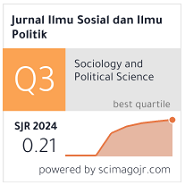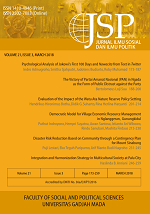Pilkada Amidst a Pandemic: The Role of The Electronic Word of Mouth in Political Brand and Voting Intention
Linda Fitriani(1*), Jono M Munandar(2), Ujang Sumarwan(3)
(1) Management Science, IPB University, Indonesia
(2) Department of Management, IPB University, Indonesia
(3) Graduate Program in Management and Business, IPB University, Indonesia
(*) Corresponding Author
Abstract
The Regional Head Election campaign frequently uses electronic Word of Mouth (eWOM) communication because of social media's growth and the Covid-19 pandemic that took place during the election year. In commercial brands, eWOM impact has influence brand equity and purchase decisions. However, in political brands, this has not been proven. Therefore, by using the regional head candidate of Purbalingga Regency as a political brand, this study examines the effect of eWOM on developing candidate brand equity and relates it to voting intention. Brand equity using a brand pyramid model with brand equity forming variables consisting of a candidate brand awareness, a candidate brand performance-imagery, a candidate brand judgment-feelings, and a candidate brand resonance. The study involved 260 respondents who are people of Purbalingga Regency who may vote and use social media. The sampling method used was purposive sampling by conducting direct interviews with respondents. Data were analyzed using Structural Equation Model Partial Least Square (SEM PLS) analysis. The results showed that electronic Word of Mouth has a positive and significant effect on brand equity development variables. Developing brand equity affects the voting intention on candidate brand awareness and candidate brand resonance. The Result of this study found electronic Word of Mouth to have no direct influence on voting intention.
Keywords
Full Text:
PDFReferences
Abdillah, W., & Hartono, J. (2016). Partial Least Square (PLS) Alternatif Structural Equation Modeling (SEM) dalam Penelitian Bisnis. Penerbit Andi.
Abdillah, W., & Jogiyanto, H. (2015). Partial Least Square (PLS) Alternatif Structural Equation Modeling (SEM) dalam Penelitian Bisnis. Yogyakarta: Penerbit Andi.
Abubakar, A. M., Ilkan, M., & Sahin, P. (2016). eWOM, eReferral and gender in the virtual community. Marketing Intelligence and Planning, 34(5), 692–710. https://doi. org/10.1108/MIP-05-2015-0090
Ahmed, M. A., Lodhi, S. A., & Ahmad, Z. (2017). Political Brand Equity Model: The Integration of Political Brands in Voter Choice. Journal of Political Marketing, 16(2),147–179. https://doi.org/10.1080/15377857.2015.1022629
Ajzen, I. (2013). Theory of Planned Behaviour Questionnaire. Measurement Instrument Database for the Social Science, 2–9. https://doi.org/http://dx.doi.org/10.13072/midss.649
Alhidari, A., Iyer, P., & Paswan, A. (2015).Personal level antecedents of eWOM and purchase intention, on social networking sites. Journal of Customer Behaviour, 14(2),107–125. https://doi.org/10.1362/147539215x14373846805707
Augusto, M., & Torres, P. (2018). Effects of brand attitude and eWOM on consumers’ willingness to pay in the banking industry: Mediating role of consumer- brand identification and brand equity. Journal of Retailing and Consumer Services,42 (1–10). https:/ / doi.org/ 10.1016/ j.jretconser.2018.01.005
Cheng, Y. Y., Tung, W. F., Yang, M. H., & Chiang, C. T. (2019). Linking relationship equity to brand resonance in a social networking brand community. Electronic CommerceResearch and Applications. https://doi.org/10.1016/j.elerap.2019.100849
Cheung, C. M. K., & Thadani, D. R. (2012). The impact of electronic word-of-mouth communication: A literature analysis and integrative model. Decision Support Systems, 54(1), 461–470. https://doi.org/ doi:10.1016/j.dss.2012.06.008
Chu, S. C., & Kim, Y. (2011). Determinants of consumer engagement in electronic Word- Of-Mouth (eWOM) in social networking sites. International Journal of Advertising,30(1), 47–75. https://doi.org/10.2501/IJA-30-1-047-075
Creswell, J. W. (2016). Research Design (Pendekatan Metode Kualitatif, Kuantitatif, dan Campuran). Yogyakarta: Pustaka Pelajar.
Cwalina, W., & Falkowski, A. (2015). Political Branding: Political Candidates Positioning Based on Inter-Object Associative Affinity Index. Journal of Political Marketing, 14(1–2), 152–174. https://doi.org/10.1080/15377857.2014.990842
Dabula, N. (2017). The Influence of Political Marketing Using Social Media on Trust, Loyalty and Voting Intention of the Youth of South Africa. Business & Social Sciences Journal (BSSJ), 2(1), 63–119. https://doi.org/10.26831/bssj.2016.2.1.62-112
Dewenter, R., Linder, M., & Thomas, T. (2019). Can media drive the electorate? The impact of media coverage on voting intentions. European Journal of Political Economy.58, 245-261. https://doi.org/10.1016/j.ejpoleco.2018.12.003
Felix, R., Rauschnabel, P. A., & Hinsch, C. (2017). Elements of strategic social media marketing: A holistic framework. Journal of Business Research. 70, 118-126. https:// doi.org/10.1016/j.jbusres.2016.05.001
Ghozali, I. (2008). Structural Equation Modelling (Edisi II). Universitas Diponegoro.
Godey, B., Manthiou, A., Pederzoli, D., Rokka, J., Aiello, G., Donvito, R., & Singh, R. (2016). Social media marketing efforts of luxury brands: Influence on brand equity and consumer behavior. Journal of Business Research, 69(12), 5833–5841. https://doi. org/10.1016/j.jbusres.2016.04.181
Grothaus, M. (2016). Inside Bernie Sanders’s Social Media Machine. Retrieved from https:// www.fastcompany.com/3058681/inside- bernie-sanders-social-media-machine
Hair, J. F., Risher, J. J., Sarstedt, M., & Ringle, C. M. (2019). When to use and how to report the results of PLS-SEM. European Business Review, 00–00. https://doi.org/10.1108/ EBR-11-2018-0203
Hennig-Thurau, T., Gwinner, K. P., Walsh, G., & Gremler, D. D. (2004). Electronic word-of-mouth via consumer-opinion platforms: What motivates consumers to articulate themselves on the Internet? Journal of Interactive Marketing, 18(1), 38–52. https://doi.org/10.1002/dir.10073
Hennig-Thurau, T., Wiertz, C., & Feldhaus, F. (2015). Does Twitter matter? The impact of microblogging word of mouth on consumers’ adoption of new movies. Journal of the Academy of Marketing Science,43(3), 375–394. https://doi.org/10.1007/s11747-014-0388-3
Hollebeek, L. D., & Macky, K. (2019). Digital Content Marketing’s Role in Fostering Consumer Engagement, Trust, and Value: Framework, Fundamental Propositions, and Implications. Journal of Interactive Marketing, 45, 27–41. https://doi. org/10.1016/j.intmar.2018.07.003
Hu, X. (2014). Who Are Fans of Facebook Fan Pages?An Electronic Word of Mouth Communication Perspective. International Journal of Cyber Society and Education. https://doi.org/10.7903/ijcse.1156
Hultman, M., Ulusoy, S., & Oghazi, P. (2019). Driv ers and outcomes of political candidate image creation: The role of social media marketing. Psychology and Marketing, 1–11. https://doi.org/10.1002/ mar.21271
Iyer, P., Yazdanparast, A., & Strutton, D. (2017). Examining the effectiveness of WOM/eWOM communications across age-based cohorts: implications for political marketers. Journal of Consumer Marketing, 34(7), 646–663. https://doi.org/ doi.org/10.1108/JCM-11-2015-1605
Keller, K. L. (2013). Strategic Brand Banagement (global edition). UK: Pearson Education.
Keller, K. L. (2020). Leveraging secondary associations to b uild b rand equity: theoretical perspectives and practical applications. International Journal of Advertising, 1–18. https://doi.org/10.1080/02650487.2019.1710973
Kim, A. J., & Ko, E. (2012). Do social media marketing activities enhance customer equity? An empirical study of luxury fashion brand. Journal of Business Research, 65(10), 1480–1486. https://doi. org/10.1016/j.jbusres.2011.10.014
King, R. A., Racherla, P., & Bush, V. D. (2014). What we know and don’t know about online word-of-mouth: A review and synthesis of the literature. Journal of Interactive Marketing, 28(3), 167-183. https:// doi.org/10.1016/j.intmar.2014.02.001
KPU-Purbalingga. (2015). Hasil Hitung TPS Kabupaten Purbalingga. Retrieved from https://pilkada2015.kpu.go.id/ purbalinggakab
KPU. (2020a). KPU Dorong Kampanye Pilkada 2020 Optimalkan Media Daring. https://nasional. kompas.com/read/2020/09/24/17351871/ kpu-dorong-kampanye-pilkada-2020- optimalkan-media-daring?page=all
KPU. (2020b). Peraturan Komisi Pemilihan Umum RI. Retrieved from https://jdih.kpu.go.id/ detailpkpu-6a4d54587041253344253344
Kudeshia, C., & Kumar, A. (2017). Social eWOM: does it affect the brand attitude and purchase intention of brands? Management Research Review, 40(3), 310–330. https://doi.org/10.1108/MRR-07-2015-0161
Mooradian, T. A., & Swan, K. S. (2006). Personality-and-culture: The case of national extraversion and word-of- mouth. Journal of Business Research ,59(6), 778–785. https://doi.org/10.1016/j.jbusres.2006.01.015
Needham, C., & Smith, G. (2015). Introduction: Political Branding. Journal of Political Marketing, 14(1–2), 1–6. https://doi.org/10.1080/15377857.2014.990828
Parker, B. T. (2012). Candidate Brand Equity Valuation: A Comparis on of U. S. Presidential Candidates During the 2008 Primary Election Campaign. Journal of Political Marketing, 11(3), 208–230. https:// doi.org/10.1080/15377857.2012.699424
Pemkab-Purbalingga. (2020). Tentang Purbalingga.
Pew. (2015). Mobile Messaging and Social Media 2015. In Pew Research Center.
Pramuk, J. (2016). Trump expected to name fast food CEO Andy Puzder as pick for Labor secretary. CNBC.
Rachmat, M. (2014). The Impact of Political Brand Trust on Voting Intention: Evidence from 2013 North Maluku Governor Election. The IUP Journal of Brand Management.
Rohmah, N. N. (2020). Media Sosial Sebagai Media Alternatif Manfaat dan Pemuas Kebutuhan Informasi Masa Pandemik Global Covid 19 (Kajian Analisis Teori Uses And Gratification). Al-I’lam: Jurnal Komunikasi Dan Penyiaran Islam, 1–16.
Rutter, R., Roper, S., & Lettice, F. (2016). Social media interaction, the university brand and recruitment performance. Journal of Business Research, 69(8), 3096–3104. https:// doi.org/10.1016/j.jbusres.2016.01.025
Saboo, A. R., Kumar, V., & Ramani, G . (2016). Evaluating the impact of social media activities on human brand sales. International Journal of Research in Marketing, 33(3), 524–541. https://doi. org/10.1016/j.ijresmar.2015.02.007
Saridakis, C., Baltas, G., Oghazi, P., & Hultman, M. (2016). Motivation Recipes for Brand-Related Social Media Use: A Boolean—fsQCA Approach. Psychology and Marketing, 33(12), 1062–1070. https:// doi.org/10.1002/mar.20940
Schofield, P., & Reeves, P. (2015). Does the factor theory of satisfaction explain political voting behaviour? European Journal of Marketing, 49(5/6), 968–992. https://doi.org/10.1108/EJM-08-2014-0524
Schweidel, D. A., & Moe, W. W. (2014). Listening in on social media: A joint model of sentiment and venue format choice. Journal of Marketing Research, 51(4), 387–402. https:// doi.org/10.1509/jmr.12.0424
Sharifpour, Y. (2018). Effects of Electronic Word-of-Mouth on Consumers Purchase Intentions Through Brand Association in Iran Perspective. Management, 2, 1–12. https://doi.org/10.31058/j.mana.2018.21001
Sijoria, C., Mukherjee, S., & Datta, B. (2018). Impact of the antecedents of eWOM on CBBE. In Marketing Intelligence and Planning. https://doi.org/10.1108/MIP-10-2017-0221
Susanto, E . H. (2017). M E DIA SOSIAL SEBAGAI PENDUKUNG JARINGAN KOMUNIKASI POLITIK. Jurnal ASPIKOM, 3(3), 379–398. https://doi. org/10.24329/aspikom.v3i3.123
Tinarbuko, S. (2019). Membaca Makna Iklan Politik Pilpres 2019. Mudra Jurnal Seni B uda ya , 34 (2), 250–258. https ://d o i. org/10.31091/mudra.v34i2.707
Van Steenburg, E., & Guzmán, F. (2019). The influence of political candidate brands during the 2012 and 2016 US presidential elections. European Journal of Marketing, 53(12), 2629–2656. https://doi.org/10.1108/ EJM-06-2018-0399
Yuan, C. L., Kim, J., & Kim, S. J. (2016). Parasocial relationship effects on customer equity in the social media context. Journal of Business Research, 69(9), 3795–3803. https:// doi.org/10.1016/j.jbusres.2015.12.071
Article Metrics
Refbacks
- There are currently no refbacks.
Copyright (c) 2021 Jurnal Ilmu Sosial dan Ilmu Politik

This work is licensed under a Creative Commons Attribution-NonCommercial-NoDerivatives 4.0 International License.






















